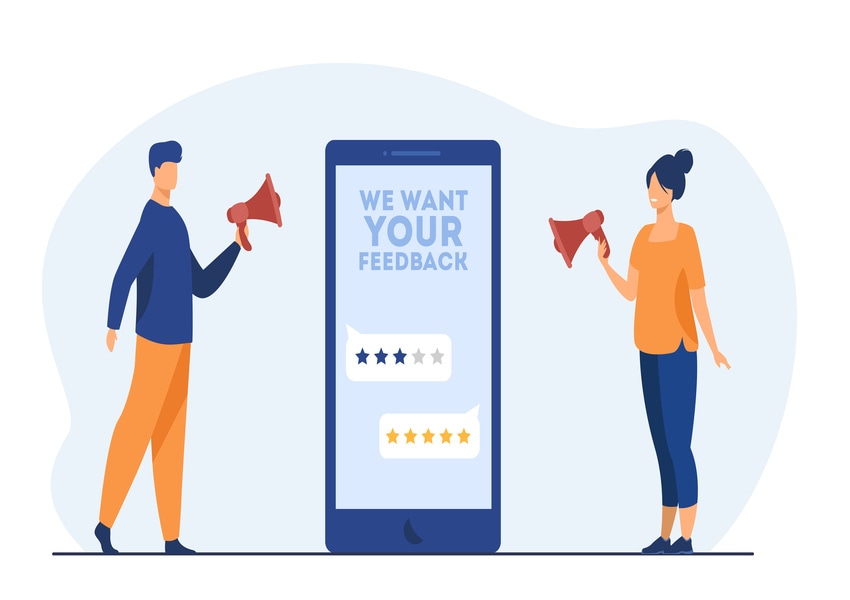Take Feedback Seriously
If your app hasn’t taken off and you’re seeing negative reviews, it’s tempting to want to block that out. But to move forward successfully, you need to know where you got it wrong and hear honest feedback that will give insight as to how to improve.
In fact, not responding to feedback could make your situation worse. Users want to know that app developers are invested in creating a tool that will help them solve a problem or make them more productive. Show that you’re open to feedback and ask for suggestions. Convince reviewers that you’re dedicated to making improvements.
There are ways to find out what potential users are looking for in your app or one like yours. Take advantage of the opportunity to welcome comments on social media. Then, participate in a broader forum by joining online groups where your target users ask questions and vent issues.
You’ll get a good sense about what frustrates members about your app and competitors’ offerings. Get a deeper understanding of their pain points so you can work on how to relieve them. We used our knowledge of driving students’ struggles to get through the Queensland road rules book to design an easier way to learn the road rules and absorb essential information.
It’s okay to identify your brand when you become a member of this kind of a group, but demonstrate that you’re there as an interested observer – not someone who’s trying to actively sell. The way you react and respond to feedback and suggestions will not only help you to provide better features, but it’s also a good public relations strategy.

Strive to Become an Expert in Your Field
Building expertise is a sure way to be able to better address your target customers’ needs. But it’s also a way to enhance your credibility, reputation, and brand image. When prospective users see your brand as an industry leader, they’re more likely to trust that you’ll be able to deliver on your promises. They may even search for you by name.
Of course, you’ll need to do the legwork to build your expertise, but when it’s time to promote your ideas and knowledge, there are a couple of good options to make your brand more visible.
Participate in industry seminars
Brands that are showcased in industry seminars are automatically granted credibility since the organization that hosts the seminar passes authority onto its participants. Most of the seminars are now taking place as online webinars, but that format makes it easier to gain a large audience that otherwise wouldn’t be able to take time off to travel.
Pitch article ideas to journalists in the field
If you have a story to tell that’s relevant to your industry, pitch it to a journalist who writes for audiences who work in the field. It doesn’t have to be a high-circulation publication, but make sure it’s well-regarded and highly targeted.
Once you’ve confirmed your appearances, it’s time to promote them. Securing access to video footage of your presentation is a great way to engage your fans and those who do not yet know you but are interested in the subject matter. Should your article appear in an upcoming publication, tease it before its release, and then show an excerpt of the article (that you link to) in online spaces where other industry leaders are likely to hang out.
Do you want to generate traffic for your app?
Contact Growth Hackers
Don’t Give Up, Optimize Instead
There’s no reason to quit just because that launch isn’t all that you thought it would be. Instead, turn your attention to analytics to determine exactly where you need to improve and which efforts were successful enough to build on.
Companies that have the greatest likelihood of outperforming competitors use several sources of integrated customer and marketing data. There are so many tools available that will help you monitor how your app is performing.
These tools provide a wide range and depth of information, tracking key performance indicators (KPI), such as:
• Number of downloads and installs
• Number of daily active users
• Time spent in-app
• Number of uninstalls and churn rate
• Crash report data
• Number of people who upgraded to a premium version
• User retention rate
• Cost per acquisition
• Number of sessions and session length
• Daily and monthly active users
Once you’ve determined your KPIs and discovered which areas need more work, you’ll be in a better position to focus on improving what matters most.
If you see that your downloads and installs have dropped at an alarming rate, revisit app store optimization (ASO) to find the keywords that will boost your position in search and result in people downloading and installing the app. Since high-value keywords do change over time, it’s a wise decision to continue monitoring the strength of the words you’re currently using in your app title and description.
We constantly monitor our download numbers to ensure we’re using the most valuable keywords on our driver knowledge test app store listing page.
Improve Results with A/B Testing
Your lack of growth may have something to do with the app itself, but it’s also possible that your ad creative isn’t performing as well as it could. A/B split testing allows you to experiment with the features and marketing of your app with a smaller portion of your user base before you roll it out to the general public.
Before you can set up an A/B test, you need to establish a hypothesis. For example, you may think you know how to set up an in-app feature that will be attractive to users, but you’ll be able to verify whether or not your hypothesis is correct by showing half of the experimental group your idea and the other half an alternative idea. When the results come back, you’ll feel more confident about moving forward in one direction or the other.
When conducting an A/B test, make sure that you choose a sample that’s representative of your entire user base, is large enough to be reliable and statistically significant, and allow enough time for the experiment to run.
Ideas for product (App) testing
• Push Notifications – How often to use them and the content of the messages may be worthwhile to test.
• Images – Does one image lead to more downloads than the other image? Will a particular color be more effective?
• Personalization – How can it best be used to increase app usage or re-engage users who haven’t visited in a while
Ideas for ad testing
• Keywords – Are you using the correct keywords to drive people to the app store?
• Deep-Linking – Which page will improve your KPIs if you link directly to it?Be sure to test only one variable at a time. When you begin introducing more options, you won’t have a clear idea as to which version was associated with better results.

At First, Aim for Growth Instead of Revenue
There’s no question that revenue is an important metric. The ability to keep your business alive depends on the money you bring in. You should start tracking data right after your mobile app development process is completed but measuring success on revenue when you first launch your app doesn’t give you any insight as to how you earned that revenue and how you’ll sustain it.
Pay attention to your app’s growth trajectory (or lack thereof) – and dig into the data that shows where your users are dropping out. From there you can develop strategies to retain current users and keep new users that find you in the app stores. Considering the level of competition among current apps – and how many new apps are introduced each day – it’s vital to hold on to the users you currently have, since it’s more expensive to retain a customer than to attract a new one.
Competition also makes it difficult to attract a large number of users at the outset, unless your brand is already well known. You’ll be able to eventually meet your revenue goals if you first concentrate on providing value to the people who are currently using your app. Satisfied customers will boost your ratings, promote and generate traffic for your app through word-of-mouth.
Generate successfully traffic for your app!
Work with Growth Hackers
Learning From Your Mistakes is the Key to Your Success
Believe in your app’s potential to help or entertain people. Don’t let a poor launch discourage you from moving forward with it. There are so many tools available to us – both high- and low-tech. There’s no doubt that if you focus on what didn’t work and set out to improve on those areas, you’ll be able to generate traffic for your app, and begin to see your downloads and usage climb.
Generate Traffic for Your App and Grow Your Business
Achieve tremendous growth for your app by providing an impressive user experience and implementing a successful marketing campaign. With the correct tools and appropriate strategy, you will build buzz and generate traffic for your app, increase downloads and installs, and trigger valuable user feedback in the community.
Growth Hackers is a mobile marketing agency that helps small and medium businesses grow their audience, get more leads, and increase their revenues. We can help you propel your app to the next level by executing an effective digital marketing campaign including SEO, website development, branding, email marketing, paid ads, and paid social media. If you want to generate traffic for your app, contact Growth Hackers now!




